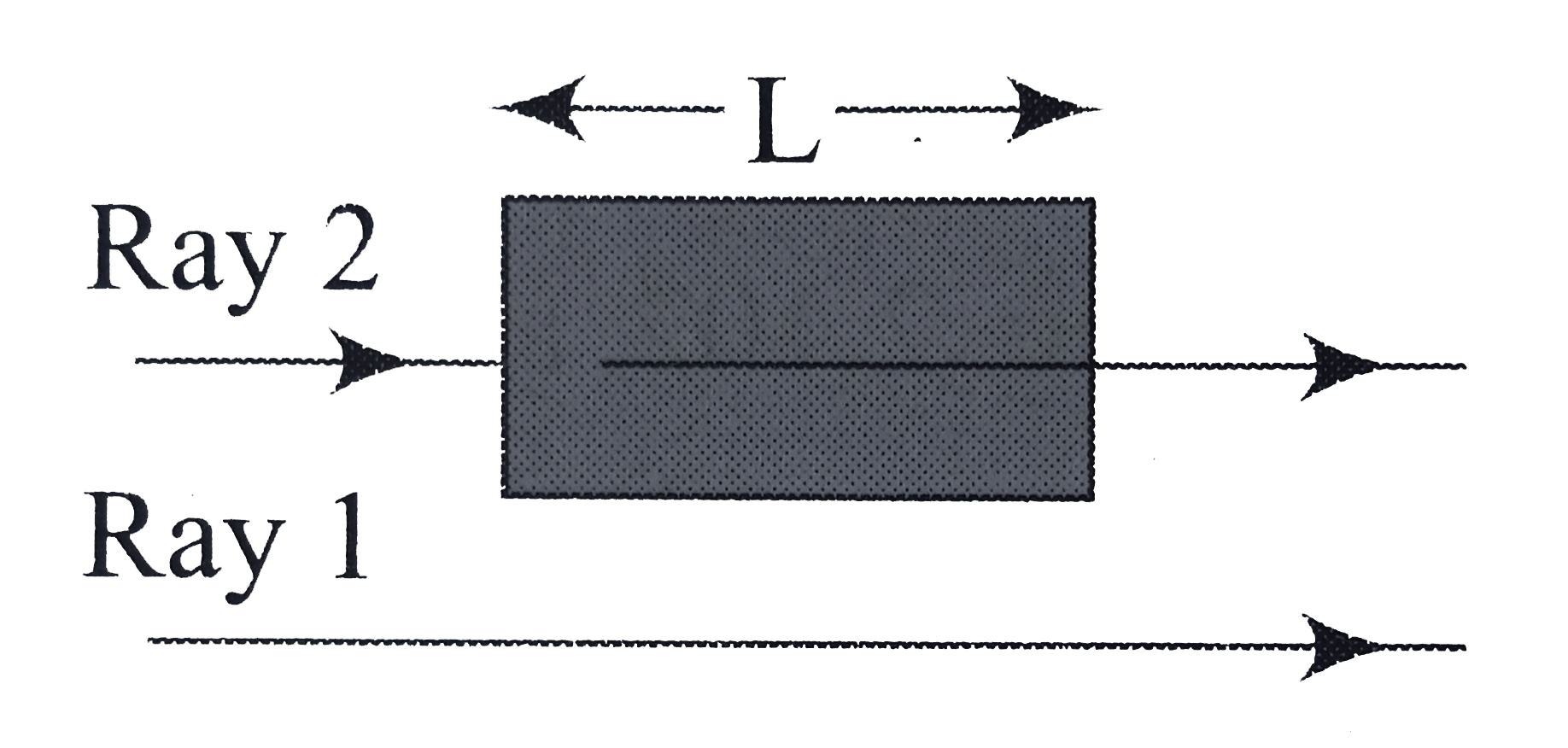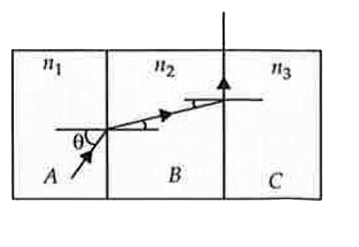As shown in figure waves with identical wavelengths and amplitudes and which are intially in phase travel through difference media. Ray 1 travels through air and Ray 2 through a transparent medium for equal length L, in four different situations. Rays reach a common point on the screen. The number of wavelengths in length L is N2 for Ray 2 and N1 for Ray 1. In the following table, values of N1 and N2 are given for all four situations. The order or the situations according to the intensity of the light at the common point in descending order is Situations
1 2 3 4
N1 2.75 1.80 3.00 3.25
N2 2.75 2.80 3.25 4.00
 Solution in Gujrati
Solution in Gujrati
I3=I4>I2>I1
I1>I3=I4>I2
I1>I2>I3>I4
I2>I3=I4>I1
The correct Answer is:D
Path difference
Δx1=λ2,Δx2=λ,Δx3=λ4,Δx4=3λ4
Therefore I2>I3=I4I1
Topper's Solved these Questions
- BOOK - ALLEN CHAPTER - WAVE OPTICSEXERCISE - Exercise 3 (Miscellaneous type Questions)27videos
WAVE OPTICS
- BOOK - ALLEN CHAPTER - WAVE OPTICSEXERCISE - Exercise 4 A (Conceptual subjective Exercise)9videos
WAVE OPTICS
- BOOK - ALLEN CHAPTER - WAVE OPTICSEXERCISE - Exercise 1 (Check your Grasp)75videos
WAVE OPTICS
- BOOK - ALLEN CHAPTER - UNIT & DIMENSIONS, BASIC MATHS AND VECTOR EXERCISE - Exercise (J-A)7videos
UNIT & DIMENSIONS, BASIC MATHS AND VECTOR
Similar Questions
Statement-1: if white light is used in YDSE, then the central bright fringe will be white.
Statement-2: In case of white light used in YDSE all the wavelengths produce their zero order maxima at the same position.03:32View SolutionConsider interference between two sources of intensity I and 4I. Find out resultant intensity where phase difference is (i). π/4
(ii). π
(iii). 4π02:28View SolutionWhich of following phenomenon is not to explained by Huygen's construction of wavefront?
02:27View SolutionMatch List I with List II and select the correct answer using the codes given below the lists :
 View Solution
View SolutionAs shown in figure waves with identical wavelengths and amplitudes and which are intially in phase travel through difference media. Ray 1 travels through air and Ray 2 through a transparent medium for equal length L, in four different situations. Rays reach a common point on the screen. The number of wavelengths in length L is N_(2) for Ray 2 and N_(1) for Ray 1. In the following table, values of N_(1) and N_(2) are given for all four situations. The order or the situations according to the intensity of the light at the common point in descending order is Situations 1 2 3 4 N_(1) 2.75 1.80 3.00 3.25 N_(2) 2.75 2.80 3.25 4.00
View SolutionIn electromagnetic spectrum, the frequencies of γ-rays and X−rays and ultraviolet rays are denoted by n1,n2 and n3 respectively, then
View SolutionIn electromagnetic spectrum , the frequencies of alpha - rays , X - rays and ultraviolet rays are denoted by n_(1) , n_(2) and n_(3) respectively then
02:46View SolutionTwo light rays having the same wavelength lambda in vacuum are in phase initially. Then the first ray travels a path L_(1) through a medium of refractive index n_(1) while the second ray travels a path of length L_(2) through a medium of refractive index n_(2) . The two waves are then combined to observe interference. The phase difference between the two waves is :
03:48View SolutionLight rays travel through a transparent medium
03:48View SolutionLight rays travel through a transparent medium
04:26View SolutionA,B and C are the parallel sided transparent media of refractive index n1,n2 and n3 respectively.
The are arranged as shown in the figure. A ray is incident at an angle θ on the surface of separation of A and B which is as shown in the figure. After the refraction into the medium B, the ray grazes the surface of separation of the media B and C. Then, sinθ= View Solution
View SolutionTwo light waves having the same wavelength lambda in vocume are in phase initially. Then the first ray travels a path of length L_(1) through a medium of refractive index mu_(1) . The second ray travels a path of length L_(2) through a medium of refractive index mu_(2) . The two waves are then combined to observe interference effects. The phase difference between the two when they interfere, is
02:48View SolutionTwo light waves having the same wavelength lambda in vocume are in phase initially . Then the first ray initially . Then the first ray travels a path of length L_(1) through a medium of refractive index mu .The second ray travels a path of length L_(2) through a medium of refractive index mu_(2) .The two waves are then combined to observe interference effects . The phase difference between the two , when they interfere is
03:25View SolutionA ray of light passes through four transparent media with refractive index n_(1),n_(2),n_(3)andn_(4) as shown. The surface of all media are parallel If the emergent ray DE is parallel to incident ray AB, then
View SolutionA ray of light travels in the way as shown in the figure. After passing through water, the ray grazes along the water air surface. The value of μg interms of I is
 02:07View Solution
02:07View SolutionA ray of light passes through four transparent media with refractive index n_(1) ,n_(2),n_(3) and n_(4) as shown, the surface of all media are parallel If the emergent ray DE is parallel to incident ray AB, then
02:32View Solution

